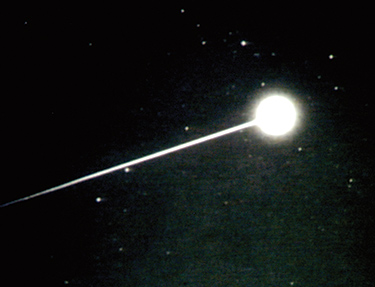Comet dust may unlock secrets of the solar system, says UW professor

The Stardust capsule streaks across the Utah sky as it returns to Earth. Photo courtesy of NASA.
After traveling 2.88 billion miles over nearly seven years, NASA’s Stardust capsule landed in the Utah desert on Jan. 15, bringing back comet samples that could help explain the origins of the solar system.
Scientists are currently studying tens of thousands of comet grains from the Wild 2 comet (pronounced Vilt 2), captured two years ago beyond the orbit of Mars. UW Astronomy Professor Donald Brownlee, who is Stardust’s principal investigator, believes the comet dust carries evidence of how the sun and the solar system formed more than 4 billion years ago.
“What’s really exciting to me is that we soon expect to have this cosmic library in the laboratory so that we can try to read those records of our earliest history,” Brownlee says. “Our seven-year journey actually went back in time 4.5 billion years to gather these primitive samples.”
Stardust, launched by NASA from Cape Canaveral, Fla., on Feb. 7, 1999, encountered Wild 2 on Jan. 2, 2004. It flew about 150 miles from the comet’s nucleus to capture tiny grains of dust and snap close-up photographs of the comet’s main body. Though the grains were traveling faster than rifle bullets, they were not appreciably altered because the spacecraft’s collector used a remarkable substance called aerogel that is as much as 99.9 percent empty space. The aerogel, Brownlee says, greatly reduced the effects of impact.
Brownlee likened the mission to some of the great seafaring adventures in human history. ”A lot of great explorers didn’t make it back,” he says. “This is the longest return voyage. Nothing has ever gone this far away and come back.”